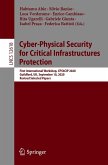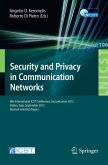Abhijit Mohanta, Anoop Saldanha
Malware Analysis and Detection Engineering (eBook, PDF)
A Comprehensive Approach to Detect and Analyze Modern Malware
67,95 €
67,95 €
inkl. MwSt.
Sofort per Download lieferbar

34 °P sammeln
67,95 €
Als Download kaufen

67,95 €
inkl. MwSt.
Sofort per Download lieferbar

34 °P sammeln
Jetzt verschenken
Alle Infos zum eBook verschenken
67,95 €
inkl. MwSt.
Sofort per Download lieferbar
Alle Infos zum eBook verschenken

34 °P sammeln
Abhijit Mohanta, Anoop Saldanha
Malware Analysis and Detection Engineering (eBook, PDF)
A Comprehensive Approach to Detect and Analyze Modern Malware
- Format: PDF
- Merkliste
- Auf die Merkliste
- Bewerten Bewerten
- Teilen
- Produkt teilen
- Produkterinnerung
- Produkterinnerung

Bitte loggen Sie sich zunächst in Ihr Kundenkonto ein oder registrieren Sie sich bei
bücher.de, um das eBook-Abo tolino select nutzen zu können.
Hier können Sie sich einloggen
Hier können Sie sich einloggen
Sie sind bereits eingeloggt. Klicken Sie auf 2. tolino select Abo, um fortzufahren.

Bitte loggen Sie sich zunächst in Ihr Kundenkonto ein oder registrieren Sie sich bei bücher.de, um das eBook-Abo tolino select nutzen zu können.
A one-stop solution for Malware Analysis, Reversing and Detection Engineering Covers Binary Instrumentation, Windows ETW and Suricata IDS for malware detection Presents hands-on lab solutions highlighting real world malware samples
- Geräte: PC
- ohne Kopierschutz
- eBook Hilfe
- Größe: 50.04MB
Andere Kunden interessierten sich auch für
![Cyber-Physical Security for Critical Infrastructures Protection (eBook, PDF) Cyber-Physical Security for Critical Infrastructures Protection (eBook, PDF)]() Cyber-Physical Security for Critical Infrastructures Protection (eBook, PDF)32,95 €
Cyber-Physical Security for Critical Infrastructures Protection (eBook, PDF)32,95 €![Security and Privacy in Communication Networks (eBook, PDF) Security and Privacy in Communication Networks (eBook, PDF)]() Security and Privacy in Communication Networks (eBook, PDF)40,95 €
Security and Privacy in Communication Networks (eBook, PDF)40,95 €![Selected Areas in Cryptography (eBook, PDF) Selected Areas in Cryptography (eBook, PDF)]() Selected Areas in Cryptography (eBook, PDF)64,95 €
Selected Areas in Cryptography (eBook, PDF)64,95 €![Wireless Sensor Networks (eBook, PDF) Wireless Sensor Networks (eBook, PDF)]() Wireless Sensor Networks (eBook, PDF)60,95 €
Wireless Sensor Networks (eBook, PDF)60,95 €![Computer Hacking (eBook, PDF) Computer Hacking (eBook, PDF)]() Udo KebschullComputer Hacking (eBook, PDF)29,99 €
Udo KebschullComputer Hacking (eBook, PDF)29,99 €![Identifying Malicious Code Through Reverse Engineering (eBook, PDF) Identifying Malicious Code Through Reverse Engineering (eBook, PDF)]() Identifying Malicious Code Through Reverse Engineering (eBook, PDF)72,95 €
Identifying Malicious Code Through Reverse Engineering (eBook, PDF)72,95 €![System Administration Ethics (eBook, PDF) System Administration Ethics (eBook, PDF)]() Igor LjubuncicSystem Administration Ethics (eBook, PDF)47,95 €
Igor LjubuncicSystem Administration Ethics (eBook, PDF)47,95 €-
-
-
A one-stop solution for Malware Analysis, Reversing and Detection Engineering
Covers Binary Instrumentation, Windows ETW and Suricata IDS for malware detection
Presents hands-on lab solutions highlighting real world malware samples
Dieser Download kann aus rechtlichen Gründen nur mit Rechnungsadresse in A, B, BG, CY, CZ, D, DK, EW, E, FIN, F, GR, HR, H, IRL, I, LT, L, LR, M, NL, PL, P, R, S, SLO, SK ausgeliefert werden.
Produktdetails
- Produktdetails
- Verlag: Apress
- Seitenzahl: 914
- Erscheinungstermin: 22. September 2020
- Englisch
- ISBN-13: 9781484261934
- Artikelnr.: 62288871
- Verlag: Apress
- Seitenzahl: 914
- Erscheinungstermin: 22. September 2020
- Englisch
- ISBN-13: 9781484261934
- Artikelnr.: 62288871
- Herstellerkennzeichnung Die Herstellerinformationen sind derzeit nicht verfügbar.
Abhijit Mohanta is an independent cybersecurity consultant and corporate trainer who has worked extensively in malware reverse engineering, vulnerability research, anti-virus engine development, anti-malware signature writing, and sandbox development. He has worked with the Symantec, McAfee, and Juniper Networks anti-malware labs. He holds several patents. He blogs regularly and has been a speaker at security conferences and workshops. His articles have been republished and quoted in a number of blogs and whitepapers, including eForensics magazine. He is also the author of the book Preventing Ransomware: Understand, Prevent, and Remediate Ransomware Attacks.
Anoop Saldanha is one of the core authors of the Suricata Intrusion Detection and Prevention System, funded by the US Department of Homeland Security (DHS). He works as an independent security consultant and as a corporate security trainer. He designs and develops various detection technologies to secure both the host and the network, ranging from network security tools such as IDS/IPS to malware sandboxes, malware analysis tools, firewalls, and endpoints. He holds multiple patents in the field of security and speaks at security conferences and workshops. He has previously worked in threat research labs and detection engineering teams at RSA Security, Juniper Networks, Cyphort Cybersecurity, and various other cybersecurity startups.
Anoop Saldanha is one of the core authors of the Suricata Intrusion Detection and Prevention System, funded by the US Department of Homeland Security (DHS). He works as an independent security consultant and as a corporate security trainer. He designs and develops various detection technologies to secure both the host and the network, ranging from network security tools such as IDS/IPS to malware sandboxes, malware analysis tools, firewalls, and endpoints. He holds multiple patents in the field of security and speaks at security conferences and workshops. He has previously worked in threat research labs and detection engineering teams at RSA Security, Juniper Networks, Cyphort Cybersecurity, and various other cybersecurity startups.
Part 1: Introduction.- Chapter 1. Introduction.- Chapter 2. Malware Analysis Lab Setup.- Part 2: OS and System Fundamentals.- Chapter 3. File and File Formats.-Chapter 4. Virtual Memory and the Portable Executable (PE) File.- Chapter 5. Windows Internals.- Part 3: Malware Components and Analysis.- Chapter 6. Malware Components and Distribution.- Chapter 7. Malware Packers.- Chapter 8. Persistence Mechanisms.- Chapter 9. Network Communication.- Chapter 10. Code Injection, Process Hollowing, and API Hooking.- Chapter 11. Stealth and Rootkits.- Part 4: Malware Analysis and Classification.- Chapter 12. Static Analysis.- Chapter 13. Dynamic Analysis.- Chapter 14. Memory Forensics With Volatility.- Chapter 15. Malware Payload Dissection and Classification.- Part 5: Malware Reverse Engineering.- Chapter 16. Debuggers and Assembly Language.- Chapter 17. Debugging Tricks for Unpacking Malware.- Chapter 18. Debugging Code Injection.- Chapter 19. Armoring and Evasion - The Anti Techniques.- Chapter 20. File-less, Macros, and Other Malware Trends.- Part 6: Detection Engineering.- Chapter 21. Dev Analysis Lab Setup.- Chapter 22. Anti-Virus Engines.- Chapter 23. IDS/IPS and Snort/Suricata Rule Writing.- Chapter 24. Malware Sandbox Internals.- Chapter 25. Binary Instrumentation for Reversing Automation.
Part 1: Introduction.- Chapter 1. Introduction.- Chapter 2. Malware Analysis Lab Setup.- Part 2: OS and System Fundamentals.- Chapter 3. File and File Formats.-Chapter 4. Virtual Memory and the Portable Executable (PE) File.- Chapter 5. Windows Internals.- Part 3: Malware Components and Analysis.- Chapter 6. Malware Components and Distribution.- Chapter 7. Malware Packers.- Chapter 8. Persistence Mechanisms.- Chapter 9. Network Communication.- Chapter 10. Code Injection, Process Hollowing, and API Hooking.- Chapter 11. Stealth and Rootkits.- Part 4: Malware Analysis and Classification.- Chapter 12. Static Analysis.- Chapter 13. Dynamic Analysis.- Chapter 14. Memory Forensics With Volatility.- Chapter 15. Malware Payload Dissection and Classification.- Part 5: Malware Reverse Engineering.- Chapter 16. Debuggers and Assembly Language.- Chapter 17. Debugging Tricks for Unpacking Malware.- Chapter 18. Debugging Code Injection.- Chapter 19. Armoring and Evasion - The Anti Techniques.- Chapter 20. File-less, Macros, and Other Malware Trends.- Part 6: Detection Engineering.- Chapter 21. Dev Analysis Lab Setup.- Chapter 22. Anti-Virus Engines.- Chapter 23. IDS/IPS and Snort/Suricata Rule Writing.- Chapter 24. Malware Sandbox Internals.- Chapter 25. Binary Instrumentation for Reversing Automation.







